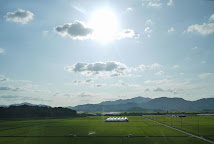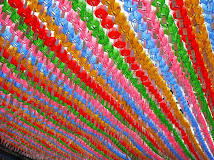Last Sunday (June 22) our language teacher Ki Ro and his girlfriend Mi Jeong, took us for a day trip southeast of Seoul to the towns of Icheon and Yeoju. These towns have a long history of ceramic manufacturing. Our stops on this trip included the Ceramic Museum at Icheon as well as the tomb of the King Sejong, Silleuksa Temple and a great restaurant in Icheon.
The weather was nice, a little hot, but better than Saturday when it rained non-stop all day. The plan was to leave early to beat the morning traffic heading out of town (Seoulites leave the city in droves on weekends). Ki Ro picked us up at a subway station in the southeast part of the city at 8 am and after picking up Mi Jeong in Bundang, we headed south and west out of the city on a relatively traffic free expressway.
First stop was "Yeongneung" the tomb of King Sejong and Queen Soheon. The tomb is located on beautiful grounds in a forest west of Yeoju. You may remember from our post about the National Museum, that back in the 14th century King Sejong commissioned the creation of the Korean alphabelt, "Hangeul". So it was very fitting that we were being taken to visit his tomb by our Korean langauge teacher! Before exploring the grounds we enjoyed a brunch of kimbap made by Mi Jeong's "oma" (mother). Mmmm good homecooking. And Jin wowed everyone with her new-found chopstick abilities.
Here we are in front of a map of the grounds and here is a portrait of King Sejong the Great.


Yeongneung is set in a beautiful forested area - not a hydro line or skyscraper to be seen. In addition to the tomb, there are various memorial (worship?) buildings, stele, statues and other monuments. There is also a tomb for Sejong's brother (who was King before Sejong) and sister-in-law and a museum. Various inventions (mostly astronomical) that were made during his reign are displayed in and around the museum. Sejong's reign is considered a kind of rennaissance during the Joseon period. Here is Lili in front of a cool jade musical instrument in the museum and photos of some of the inventions (celestial globe, armillary and a sundial).




Here is the gateway to the tomb (left) and the main memorial building at the tombsite (right). Below are a dragon's eye view of the grounds and a commemorative stele.




The tomb is a domed hillock crowned with a low stone railing and various statues. In particular there are statues of generals with swords drawn to guard the tomb and scholars commemorating the King's important scholarly contributions.




After enjoying our walk around the peaceful and interesting grounds at Yeongnueng, Ki Ro drove us to the other side of Yeoju to visit Silleuksa (or Shilleuksa) the only Korean Buddhist temple located alongside a river. Apparently Buddhist temples are typically located up on hillsides or mountain tops. This may reflect the importance of the river, the Namhan (or south Han) River, which flows into the Han River and to Seoul.
Here are Deb, Jin and Lili ready to enter the gates of the Silleuksa temple grounds. And on the right Ki Ro and Mi Jeong are leading them up the steps of the main temple building.


Below left a monk walks across the main square. Behind him are sleeping quarters used by monks or visitors. The small exquisite building in the below right photo is a memorial to some of this temples important monks, all who lived in the 14th century.


There were also temples for death and birth. The former was where families would go to pray for the souls of their departed loved ones. The photo below left shows statues of wise men judging the person's life, consulting scrolls that doument the person's life. The fate of the person's soul is determined by which way the feathers they are holding bend when they blow on them. Below right is the inside of the birth temple, where people go who want to have a child or want to pray for the health of the yet to be born baby.


There is a pavillion at Silleuksa, built on an outcrop (granite I think!) overlooking the Namhan river. The apartment blocks in the distant are at Yeoju. Here we are with Mi Jeong overlooking the river.


Mi Jeong is an elementary school teacher. You could see her love for children in how she took to our kids, especially Lili. They played kawi-pawi-po (scissors-rock-blanket, the Korean version of rock-paper-scissors) at almost every staircase. The winner of each round got to take a step or 2. Lili loves this game! And Mi Jeong loved to indulge her. Here they are playing their way down a set of stairs at Silleuksa.


The tree in the above right photo is a 600 year old gingko. Old trees are revered by Korean Buddhists. Something to do with respecting elders and nature I think.
After our pleasant tour of Silleuksa (and a marathon kawi-pawi-po session) it was time for lunch. Ki Ro took us to a great restaurant in Icheon. Here the girls are waiting outside the restaurant and there we are all sitting on the floor ready to tuck in.


Here is a shot of the great spread of food that is typical of a Korean set meal. Highlights included Icheon rice cooked in stone bowls, grilled fish (Jin and Lili loved them!), spicy tofu bean curd soup (I liked it!) and crabs. The last were a bit odd. They were probably boiled. Ki Ro instructed us to suck the mushy innards out of the pieces of broken crab legs or body. It was very salty. Jin loved it!!?! I only had one... 

After the sumptuous lunch we went to the Icheon Ceramics Museum. This is the location of the International Ceramic Biennale which was held this past May. The museum had lots of interesting, beautiful and sometimes weird pieces of ceramic art by artists around the world (including some from Canada). No photos were allowed in the museum, so you'll just have to trust me. The grounds around the museum are littered with lots of odd and interesting ceramic sculptures, including at least one of Toya, the "open-minded" mascot of Icheon. Here is the gang in front of Toya and a close-up of his flower "skin".


And here we are "in the frame". And there are my girls trying to say something to me...."sarang-heyo apa". I love you too!




The girls love "nabi" (butterflies). Did I mention that some sculptures were odd?


There was an interesting exhibit built within a mockup of a traditional kiln. In each of the kiln segments there were artistic representations of the ceramic making process. Above left is the firing room and on the right is the cooling room. A video was being projected on an umbrella-like screen. Interesting.
We had a great day with "sawn-sang-nim" (teacher) and and his "yawja chingu". We learned a little about Korean history, Buddhism, ceramics, food and most importantly people. Kamsa-hamnida!
Bye for now.
Derek, Deb, Jin and Lili





































































